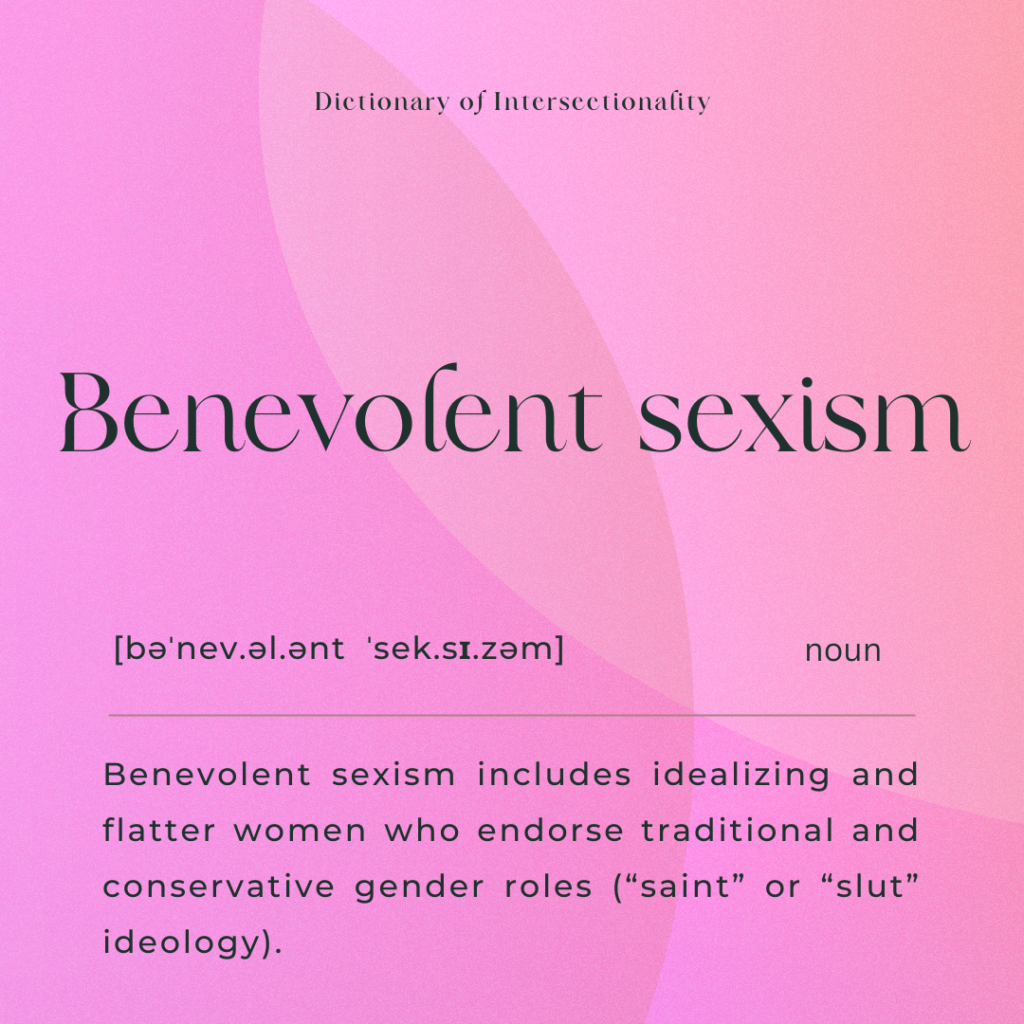
The theory of ambivalent sexism distinguishes between hostile sexism (HS) and benevolent sexism (BS). Benevolent sexism includes idealizing and flatter women who endorse traditional and conservative gender roles (“saint” or “slut” ideology).
Both hostile and benevolent sexism undermine female confidence in themselves and their abilities. BS is more socially accepted in that women are portrayed as morally pure, nurturing, innocent, and caring. These female attributions imply weakness and the need for protection in a sexist way of viewing women stereotypically, in restricted roles – formed as a compliment. BS can be used to legitimate hostility when men claim not to be sexist and even admire women. It creates a positive image for men that subtly reinforces notions of male dominance.
Due to its less obvious nature, benevolent sexism is more likely to be endorsed by all genders. For example, exposure to sexualized messages in society leads to the reinforcement of the belief that being sexually attractive is an aspect of female identity. This results – often unconsciously – in women adopting benevolent sexism as a form of self-defence.
Three sub-dimensions of BS are protective paternalism (women to be loved, cherished, & protected for their “weakness”), complementary gender differentiation (dependency of men on women, as romantic objects, wives, and mothers fosters the notion of women having many positive traits that complement those of men) and heterosexual intimacy (the belief that men need women to be complete with a focus on sexual relationships).
While it applies some positive traits to women and femininity, it still frames one sex or gender as weaker than another. These ideas can lead to policies and behaviours that limit a person’s agency, or the ability of someone to make their own choices. Usually, people who reject traditional gender roles and responsibilities are more likely not only to consider more obvious hostile aspects of sexism but also to develop sensitivity to assumptions implicit in benevolent sexism.
How to detect benevolent sexism?
Red flags for BS can be:
-basing a person’s value on their role as mother, wife or partner;
-focusing attention and praising someone’s appearance rather than their other attributes;
-believing that people should not do things for themselves, such as managing money or driving a car (because of their gender);
-assuming that a person is a nurse, assistant, or secretary – not a doctor, executive, or manager – based on their gender.
See more resources
Glick, P. & Fiske, S. T., (1996). The Ambivalent Sexism Inventory: Differentiating Hostile and Benevolent Sexism. Journal of Personality and Social Psychology. Vol. 70, No. 3, 491-512.
Glick, P., & Hilt, L. (2000). Combative children to ambivalent adults: The development of gender prejudice. In T. Eckes & H. Trautner (Eds.), The Developmental Social Psychology of Gender (pp. 243–272). Mahwah: Lawrence Erlbaum Associates.
Retrieved 03.04.2023, from https://www.dictionary.com/browse/ambivalent-sexism
Retrieved 04.04.2023, from https://www.medicalnewstoday.com/articles/types-of-sexism#benevolent
Retrieved 04.04.2023, from https://www.nature.com/articles/s44159-022-00136-x
